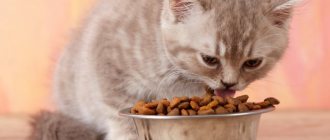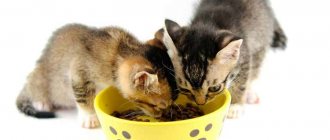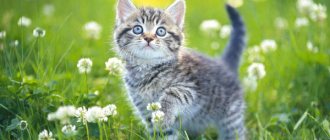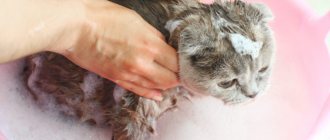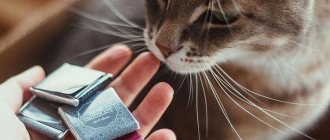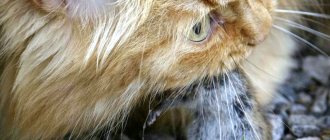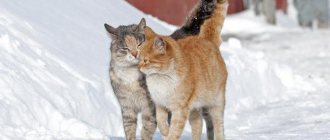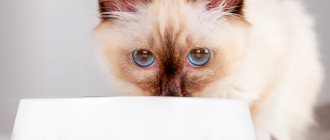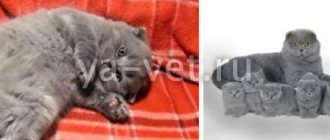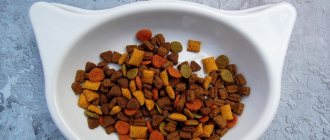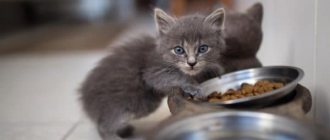Kittens are born small and completely helpless, then at first all the difficulties fall on the shoulders of the mother cat, but then 3 weeks passed and she needed the help of her owner in order to cope with these little fidgets. At three weeks of age, babies begin to move, they already see, hear, and go to the toilet on their own. Now the owner will have more problems related to caring for this wonderful creature. In addition to the question of how to protect the little fidget, a person will have another question: how to teach a kitten to eat on its own. In our article we will talk about at what age he begins to eat on his own, and how his diet needs to be changed.
At what age do kittens start eating on their own?
Under natural conditions, breastfeeding in kittens continues for a long time. The number of feedings is noticeably reduced by 2-2.5 months, and in cases where the cat has a small litter, she can continue feeding for up to six months. However, in order for your little pet to easily and painlessly switch to independent feeding, complementary foods should be introduced from three weeks of age.
A kitten should be taught to feed itself from three weeks of age.
The first weeks of a kitten’s life are the most delicate, so you need to pay attention to the baby’s nutrition. To start complementary feeding, liquid porridge is suitable. And when the kittens reach two months and their baby teeth begin to appear, solid food can be introduced. With the right and patient approach, by the age of 10 weeks the pet will be able to completely switch to solid food.
Remember that the diet must be balanced and contain the necessary elements for harmonious development. It is important to decide from the very beginning what type of complementary feeding you will use and strictly adhere to it in the future: industrial or natural. Both options can provide your little friend with the necessary vitamins and minerals, so be guided by your capabilities. However, they cannot be mixed: the digestion of dry and natural food requires different enzymes and an acidic environment. Alternating food will inevitably lead to gastrointestinal problems for your cat.
Without mother's milk
A newborn kitten needs to be fed with special formulas.
If for some reason a kitten cannot eat mother's milk in the first weeks of life, the owner will have to take on the responsibilities of the mother cat.
Remember that cat milk has a certain composition and any substitutes must be suitable for a young and sensitive body. You can purchase dry formula for feeding at a veterinary pharmacy. But they are quite expensive, so you can do the preparation yourself. Here are some recipes:
- 0.5 liters of concentrated milk, egg yolk and 4 teaspoons of granulated sugar;
- 50 g whole cow's milk, 15 g whole milk powder, 2.5 g dry yeast;
- 50 ml of whole milk, 50 g of boiled milk, half a raw egg yolk, a teaspoon of corn oil;
- Dilute concentrated milk powder in fennel broth to the consistency of liquid gruel, adding a little cream;
- a glass of 6% milk, 1 raw egg, 1 teaspoon of honey (instead of milk, you can take 10% cream, dilute with boiled water 2 times).
Cow's milk is dangerous for kittens!
Important! Do not feed your baby whole cow's milk. It does not have sufficient nutritional value and may cause digestive upset.
Regular food
Not all food that is common in human terms is suitable for a cat. A cat's stomach is delicate and sensitive, so when choosing natural complementary foods, carefully consider the list of products in your pet's diet. The wrong choice of food will provoke allergic reactions, digestive problems and even serious diseases, such as urolithiasis or gastritis. The following products are clearly prohibited for your furry friend:
- cow's milk. As we have already written, it differs in composition from cat milk, so do not try to replace natural feeding with it. It may be dangerous;
- fermented milk products with high fat content;
- freshwater and raw fish. A contented cat with a fish in its mouth is nothing more than a myth. Freshwater and raw fish can serve as a source of worms and cause urolithiasis. It is up to the owner to decide whether to introduce sea fish into the diet or not. In general, it is not dangerous, but its introduction as complementary food is not necessary at first;
It is better to leave the fish to the owners
- sausage and sausage products. It’s hard to resist the temptation to share leftovers from the holiday table with your pet, but remember that due to the high fat content and content of salt and spices, such a product will be too heavy for the cat;
- Cats do not digest potatoes in any form, so we will also include them in the list of cat prohibited foods;
- legumes Peas, beans, soy and other legumes will cause painful bloating;
- cheese has a high fat content that a kitten’s stomach cannot handle;
- pork;
- chocolate. Chocolate is a common cause of cat poisoning encountered by veterinary clinics. Chocolate contains the poison methylxanthine, or theobromine, which can cause tremors, convulsions in a kitten, increase the frequency of heart muscle contractions and even lead to death. Interesting fact: despite the fact that dark chocolate is considered healthier than milk chocolate, it contains 10 times more substances that are toxic to cats;
- flour.
It's better to leave sweets for people
The list of food dangerous for kittens is impressive, but do not rush to panic and go for industrial food. Something in your refrigerator will probably be suitable for the diet of a small pet. For example, vegetable and semolina porridge, low-fat cottage cheese, boiled egg yolk. It is important to ensure that dishes do not contain spices or additives.
What to feed
In any case, the first food for a kitten of several weeks old will be only milk or a milk substitute from a pet store. But at the age of 1 month, you can gradually introduce the first complementary foods into the baby’s diet (but still not excluding milk from the menu).
Important: it is better to show a pet that is weaned from its mother early to a veterinarian to discuss further nutrition. The specialist will teach you what to feed the baby, based on age, health (foundlings are often weakened) and the breed of the fluffy.
The list of foods allowed for such a small kitten is not yet long:
- milk;
- soft cottage cheese dissolved in milk;
- ground beef or chicken (frozen and then cooked);
- tender beef or poultry pate.
Is the kitten hungry?
It would be wonderful if kittens could tell us about their needs. But in reality, owners have to guess about the children’s desires by their behavior. How to understand that a kitten is hungry?
After feeding, your baby's tummy should be rounded and firm, but not bloated. After eating, the kitten should not meow or try to grab a finger. If he is full, he will calmly fall asleep or cuddle up to his mother. A shrill squeak and attempts to bury your face in search of the cat should be a signal for feeding. Checked on Orphogrammka up to this point
A hungry kitten will squeak and look for its mother
If the kitten squeaks and crawls around its mother, but does not take the nipple, bring a finger dipped in milk to its muzzle. If the kitten tries to suck on it, it means he is hungry and you need to help him find the nipple.
How to train kittens to eat on their own
If the kitten has a mother, the process of learning to feed itself will be easier. The cat itself will take its offspring to the bowl and set an example, and the kittens will try to pick it up. But if the kitten is left without a mother, do not despair: teaching kittens to feed on their own is quite simple.
It's better to learn with milk
The best product to try for the first time is milk. Dip your finger in it and let the kitten try it. Make sure he tries it. Then pour some milk into a bowl and bring the kitten to it. Gently tip its muzzle into the food. Most likely, at first he will not like it, but then he will recognize the taste of milk that is already familiar to him and will try to lap it up.
Let the kitten taste the milk
Don’t expect your pet to immediately run to the bowl and start eating from it: first, he needs to get used to the container and learn to lap. At first, the baby's attempts to lap from the bowl will look funny; he may snort and dirty his face. Be patient: he is learning a completely new feeding technique, because before this he only suckled his mother's milk.
Fountain for cats
Cats love to drink "live" water that comes from the tap, but most people can't leave the tap open all day, because then the utility bill will be very impressive. The ideal solution for a cat who fundamentally wants to drink only flowing water is to buy a pet fountain. The pet will be able to play with the stream and get plenty of water whenever he wants. But be sure to keep the fountain clean and fill it with fresh water every day.
Using these tips, you can train your cat to drink water, which is so important for its health. But if you have a very wayward pet, try adding catnip, which you can drop directly into the bowl. Or switch to wet food, which does not require your cat to receive additional liquid.
How to accustom a kitten to a bowl?
Owners often wonder at how many months should a kitten start eating from a bowl? By the age of three weeks, kittens show curiosity about food, or rather, about the habits of their mother. That is why you can make your first attempts to accustom a kitten to a bowl already at this age. To ensure everything goes smoothly, follow these guidelines:
- Fill the bowl with milk the first time. The milk should be heated to 37 -38 degrees. Kittens will refuse to lap if the milk is too hot or cold;
- don’t be lazy to let the contents of the bowl taste by bringing your finger with food to your muzzle;
- the kitten may refuse the bowl if its height does not suit him. Therefore, buy containers in pet stores, taking into account the dimensions of your pet;
The bowl should be the right size
- if you manage to quickly make friends with dishes, gradually replace milk with semolina porridge;
It's more fun in a bowl
- kittens can get into the bowl with all four paws, and this needs to be nipped in the bud. If the kitten climbs into a container of food, take it out, wipe its paws and place it in front of it. Hold him if he wants to climb into it again: this way you can teach your pet that his paws should not be in the food.
First weeks of life
Until the baby is one month old, he is fed about 8 times a day, or every 2-3 hours. By the age of three weeks, you can start introducing complementary foods. This should be liquid food, for example:
- vegetable and meat puree;
- low-fat cottage cheese without additives. We recommend diluting it with milk so that the cottage cheese has a liquid consistency;
- semolina porridge without sugar, also diluted with milk.
At three weeks of age, kittens are not yet able to eat on their own from a bowl, so give them their first complementary foods on a spoon or finger. At what age will a kitten be ready to start eating from a bowl on its own? If you start complementary feeding at three weeks, by the time he reaches a month he will be able to feed on his own.
When the baby is five weeks old, you should feed him 5-6 times a day. From now on, you can include boiled yolk in the menu.
Introduce complementary foods carefully, in small portions. Give your kitten time to try new foods. Despite their early curiosity about food, it will take effort for them to get used to the new feeding environment. Until the baby is one month old, stroke his tummy with your finger for better absorption of food.
Features of nutrition of a newborn kitten
For the first few weeks after birth, the baby feeds on the mother cat's milk. It contains all the nutritional elements necessary for a fragile body:
- microelements;
- antibodies that form colostral immunity, which contributes to the body’s immunity to various pathogens during breastfeeding.
The newborn baby is still weak and needs care
In the first days, the baby eats colostrum, which affects the immune system. Then it is replaced by milk. It contains antibodies that produce local immunity.
For your information! Cat milk promotes normal growth of the kitten. This feeding is the best option for a newborn pet.
Breastfeeding by a mother cat is carried out for 40-60 days from the moment the babies are born. Based on the size of the kittens, they can be breastfed for up to 6 months. But only for the first 1.5-2 months the cat provides basic nutrition.
Mom is able to feed several kittens at once
Feeding a two month old kitten
At two months, kittens develop baby teeth. This is an excellent age when introducing a kitten to solid food is simple and natural. But don’t rush to remove liquid foods from your pet’s diet: at two months of age, they are still important for the formation of the proper functioning of the digestive system. At this age, kittens are given:
- boiled lean meat;
- natural yogurt;
- low-fat cottage cheese;
- milk;
- boiled yolk.
At two months the kitten is ready for solid food
Authorized Products
Small animals allowed on the menu:
- Meat – served raw, boiled or scalded with boiling water. Only low-fat varieties are suitable. Meat products should make up from 60 to 80% of the total daily food intake.
- Liver – no more than 2 times a week.
- Porridges – any are suitable, except semolina. All kittens are not fans of cereals, but they contain many substances that the growing body needs. It is recommended to mix meat and porridge in a ratio of 2 to 1.
- Vegetables - any, except potatoes, served boiled or raw.
- Chicken eggs - small pets can only be given the yolk. Its consumption is also allowed in raw form, but not more than once every 7 days. The yolk of quail eggs can be consumed simultaneously with the white.
- Fermented milk products - any, but with a minimum percentage of fat content. The exception is sour cream; giving it to kittens is strictly prohibited.
- Oil – not vegetable oil, but Vaseline is recommended.
- Brewer's yeast - affects the coat of a small pet.
It is recommended to give your kitten an apple as a fruit.
Feeding a three month old kitten
At the age of three months, kittens' teeth change, their bones become stronger, they are playful and full of energy. They still need to be fed 5-6 times a day, but the required volumes change: for 1 kilogram of the kitten’s weight there are 200 grams of food per day. During this period, kittens need food rich in protein, and liquid food should make up less than half of the diet. For normal development of eyes and vision, taurine, which is found in meat, is necessary. Add vegetable dishes too. Enter into the menu:
- boiled lean meat - chicken, beef, turkey;
- if there are no worms, you can give raw frozen meat, chopped into small pieces;
- natural yogurt and kefir without additives;
- liquid cottage cheese;
- zucchini, pumpkin, cabbage in raw grated form. If the kitten resists, add grated vegetables to the porridge;
- boiled egg yolk;
- sea fish;
- semolina and rice porridge with milk.
Diet for feeding
By the age of one month, babies are teething, their bones are forming, and the body needs more vitamins and nutrients.
You can start complementary feeding, which consists of:
- cereal porridge with milk;
- finely chopped meat;
- boiled eggs;
- masses of cottage cheese, glucose, raw yolks;
- meat baby food.
Feeding should be done every other day, and foods should be introduced gradually in order to stop the possible development of allergic reactions in time.
Drinking regime
It is unnatural for cats to drink a lot of water. They have evolved in such a way that their water needs are almost completely satisfied by the moisture content of their food. So don't worry if your kitten seems to quench its thirst very quickly.
The daily water requirement for a kitten is calculated using a simple formula: body weight multiplied by 0.03. The resulting value includes the water contained in the feed. How much moisture is in the food is indicated on the product label as part of a guaranteed analysis. The moisture content is very different between wet and dry food and the owner should take this into account when feeding the baby.
The kitten must have access to clean water
Give your kitten clean, filtered water. The stale smell will scare the baby away and he will not drink. Also, milk and any other liquids other than water will not work.
Cats like wide bowls because they don't like their whiskers touching anything.
